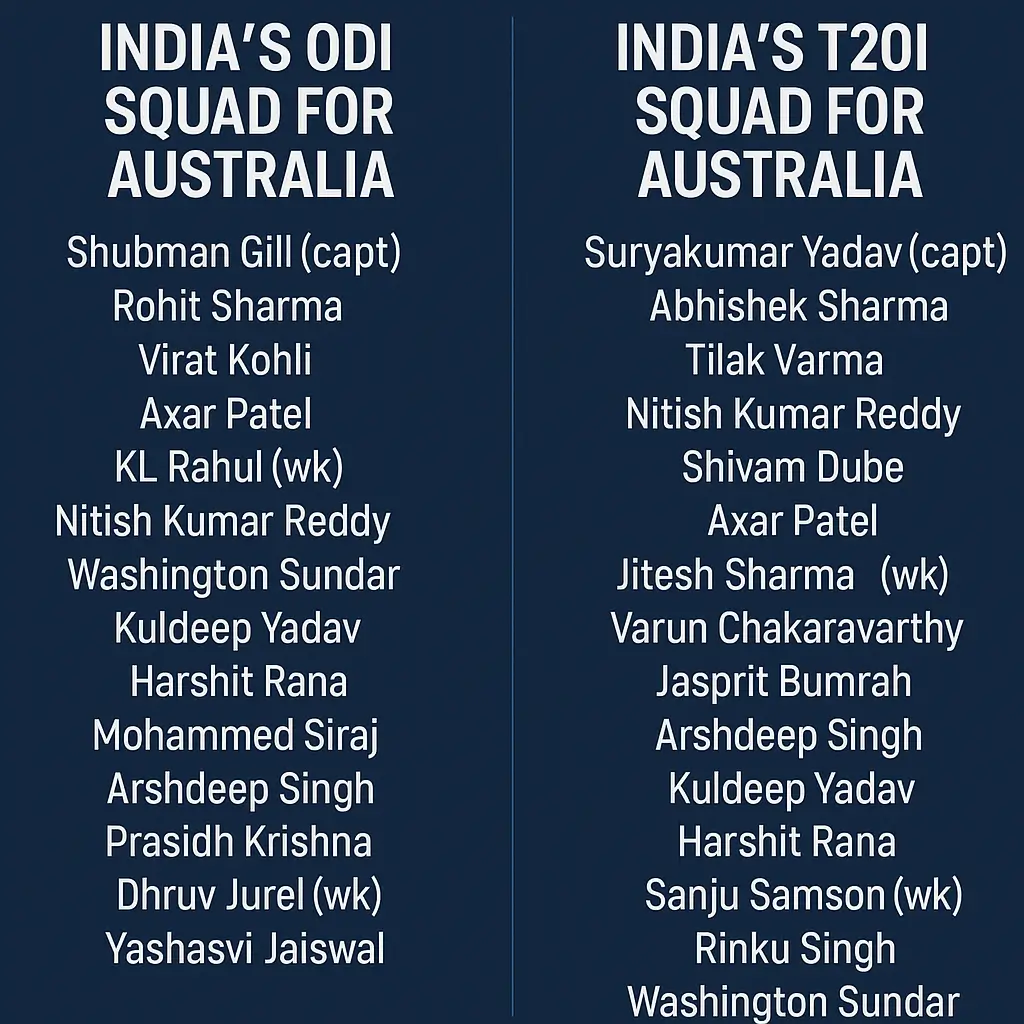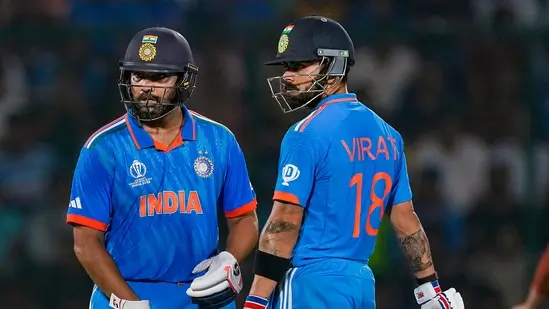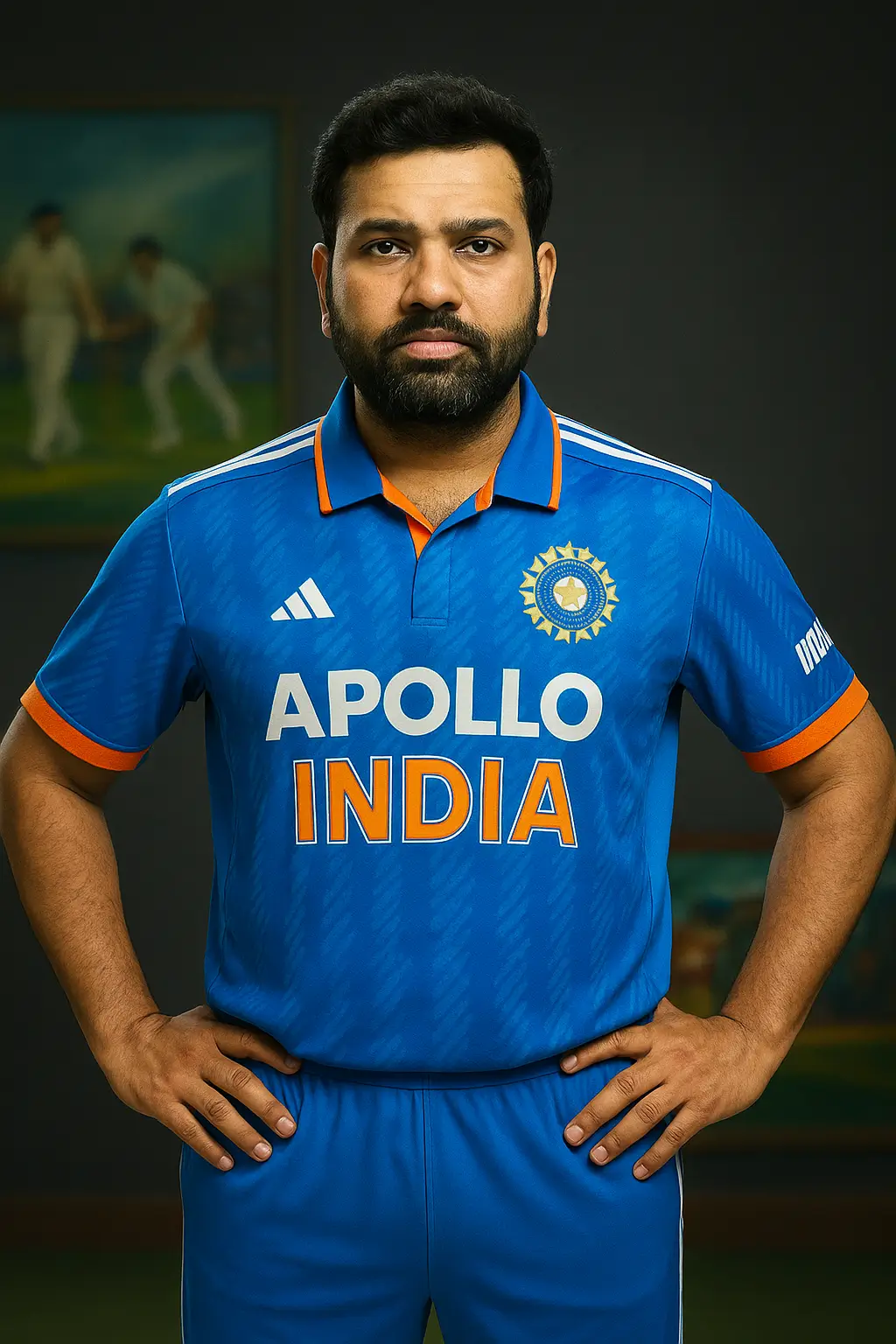India’s ODI squad for the Australia series has sparked massive discussion. Rohit Sharma and Virat Kohli are back after missing months of 50-over cricket. Both last featured in the Champions Trophy final earlier this year. Their recall shows the selectors’ trust in experience as India rebuilds for the 2027 ODI World Cup.
Shubman Gill will captain the ODI side, taking over Rohit’s former role. Shreyas Iyer acts as vice-captain, marking a shift in leadership balance. Jasprit Bumrah has been rested for workload management but stays part of the T20 setup. Meanwhile, young names like Arshdeep Singh, Nitish Kumar Reddy, and Dhruv Jurel find opportunities in the updated squad.
The selection meeting in Ahmedabad reflected clear planning. Ajit Agarkar’s panel has tried to combine continuity and experimentation. Jadeja, Pant, and Hardik Pandya miss out due to injuries or tactical choices. Their replacements bring fresh skillsets suited to Australian conditions. The next few weeks will test how the blend of experience and youth performs against top-tier opposition like Bangladesh and England.
India’s selection isn’t just about the series. It’s a roadmap—preparing a core for 2027. The management wants to maintain balance, groom backups, and test adaptability early. Let’s explore how Rohit, Kohli, and the new generation fit into this evolving puzzle.
The Road Ahead for Rohit Sharma: Can He Make 2027 His Final Chapter?
Rohit Sharma’s ODI return comes with new responsibilities and subtle pressure. He is no longer the ODI captain, but his batting remains vital for team stability. The next two years could define his final act in Indian colors. To make it to 2027, Rohit must prove he still has the hunger, fitness, and timing that made him elite.
Selectors have made it clear that every spot now depends on performance. Age will not protect reputation. With Yashasvi Jaiswal and Shubman Gill rising fast, Rohit faces competition at the top. However, his experience against quality attacks and ability to pace chases still stand unmatched. The team will count on him to anchor innings in high-pressure chases abroad.
Rohit’s biggest challenge will be maintaining sharpness over the next 24 months. He will need selective series participation and consistent domestic preparation. His current fitness program shows focus—reports suggest he’s trimmed down to stay agile. If he performs against the Australian team, he strengthens his claim for the 2027 squad. If not, the selectors may begin looking beyond him sooner than expected.
Rohit’s Evolution Beyond Captaincy
Post captaincy, Rohit’s role may turn mentor-like. His guidance will shape young openers like Gill and Jaiswal. Even without the armband, he remains a cultural anchor in India’s dressing room. He can help bridge the generational gap, ensuring calm leadership continuity. For India, Rohit’s maturity off the field is as important as his runs on it.
Why the RO-KO Reunion Matters: Beyond Runs and Records?
The decision to bring back Rohit Sharma and Virat Kohli wasn’t sentimental—it was tactical. Their presence adds mental strength to a team transitioning toward youth. Both players still rank among the best ODI batters in the world. Their inclusion brings stability to a side experimenting with combinations.
Kohli’s hunger for runs and Rohit’s calm assurance make India’s top order tougher. For young players like Reddy and Jurel, sharing a dressing room with these icons accelerates learning. The management values this unseen benefit: mentorship through presence. Agarkar’s comment that “there’s still competition for places” shows clarity—no favoritism, only merit.
For Kohli, this could be a return to ODI rhythm ahead of the 2026 Champions Trophy. For Rohit, it’s an audition for 2027. Together, they represent experience fused with accountability. Their comeback also helps balance India’s middle order, which lacked assurance after Hardik and Pant’s absence.
Rohit and Kohli’s reunion re-energizes India’s ODI culture. They bring high fitness standards and work ethic that younger players can model. Their role may evolve from frontline stars to performance stabilizers. In short, RO-KO still matter—not as nostalgia, but as the heartbeat of a changing Indian ODI system.
Arshdeep Singh’s Future: Can Consistency Secure His ODI Role?

Arshdeep Singh’s inclusion rewards his outstanding form with the Punjab Kings. His left-arm angle, swing, and control make him valuable in Australian conditions. But sustaining a place in the ODI setup requires more than IPL success. He must adapt to longer spells, use variations wisely, and remain patient.
With Bumrah rested, Arshdeep gets a golden opportunity to lead the new-ball attack. His performance could decide India’s seam balance for future tours. Ajit Agarkar emphasized managing workloads, which means opportunities will rotate. Arshdeep’s challenge is to remain impactful enough to be undroppable. His economy rate and strike consistency will be under watch.
Selectors are grooming a pool of seamers—Siraj, Prasidh, Harshit Rana—each offering unique strengths. Arshdeep’s left-arm pace gives tactical flexibility against right-hand heavy lineups. However, he must refine his death-over execution and bowling under lights. If he performs strongly, he can become Bumrah’s ideal partner by 2027.
Learning from the Senior Core
Sharing space with veterans like Kohli and Rohit can benefit Arshdeep mentally. Handling pressure, adjusting lengths, and staying composed are skills learned from seniors. The Australian tour could mark the phase where Arshdeep transforms from potential to mainstay.
India’s Vision Toward 2027: Building the Perfect ODI Machine

Planning for the 2027 ODI World Cup begins now. Shubman Gill’s promotion as ODI captain marks the beginning of India’s next era. The team management’s focus is on creating a flexible, multi-dimensional side. Players like Nitish Reddy and Dhruv Jurel bring new energy, while veterans ensure stability.
Selectors are prioritizing workload balance. Bumrah, Hardik, and Jadeja’s rotation reflects long-term thinking. The 2027 roadmap aims for a balanced squad ready for South African conditions. The bowling mix—left-arm pace, wrist spin, and power-play control—is evolving well. Batting depth from positions 6–8 is another key focus area.
Fitness, fielding, and adaptability remain non-negotiable. With frequent transitions, only players who stay consistent across formats will survive. The ODI setup now mirrors India’s T20 agility combined with Test-level maturity. This series against Australia acts as the first checkpoint toward that vision.
Data and Development Drive
The next two years will see India invest in data-driven decision-making. Analytics on strike rates, bowling speeds, and fitness levels will shape selections. Coaches will focus on developing all-rounders and finisher depth. By 2027, India hopes to arrive with an ODI squad that’s young, fearless, and strategically prepared.
Conclusion
Rohit Sharma and Virat Kohli’s return to India’s ODI team is more than selection news—it’s symbolic. It signals that experience still matters in a rapidly changing setup. For Rohit, this phase is about performance and reinvention. For Kohli, it’s another chance to mentor while competing at the highest level.
Arshdeep Singh’s rise, Jurel’s debut, and Gill’s leadership create a balanced mix of past and future. Each selection reflects clarity—India wants both legacy and renewal. The management’s 2027 vision appears bold, structured, and forward-looking.
If the veterans stay fit and the youngsters stay fearless, India’s 2027 dream looks promising. Australia will be a testing ground—not just for individual form but team direction. The new cycle has begun, and India seems ready to rebuild its next golden ODI generation.






